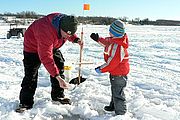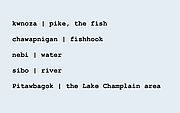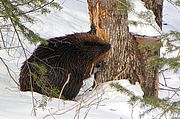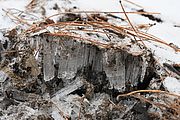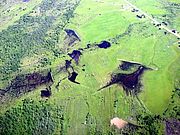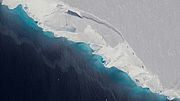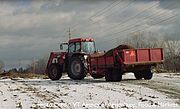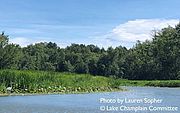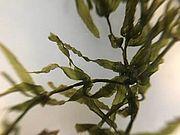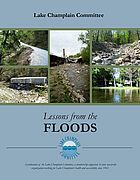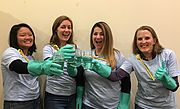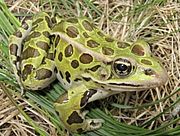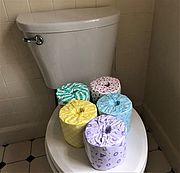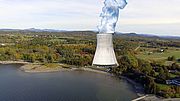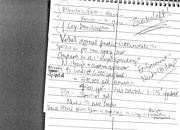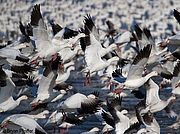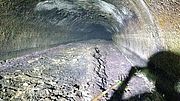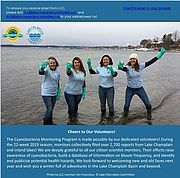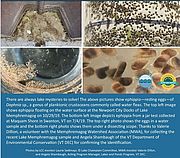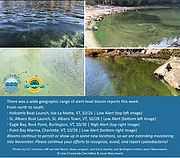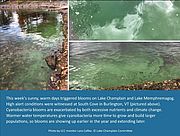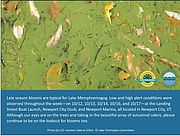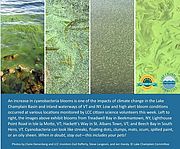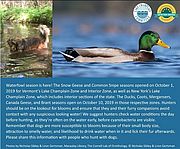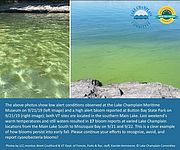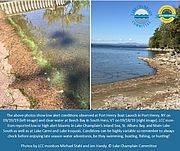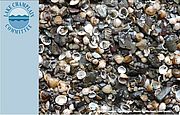There is great potential behind a hole in the ice. On Lake Champlain, those holes are often related to ice fishing. You can make ice fishing what you want it to be: a social or solo activity, over a short or long timespan, and on open ice or under the cover of a shanty. No matter the approach, it’s an activity that gets folks outside and interacting with the natural world in the wintertime.
Read...News from Selected Month
In partnership with Jesse Bowman Bruchac, a Nulhegan Abenaki citizen and a teacher of the Abenaki language, the Middlebury Language Schools is launching a pilot School of Abenaki in summer 2020. Native to New England and Quebec, the Abenaki language is considered endangered.
Read...Beavers are active year-round. Explore what a beaver lodge and dam is like in the wintertime with conservation biologist, Steve Faccio, and Outdoor Radio co-hosts, Kent McFarland and Sarah Zahendra, at a frozen beaver pond in Pomfret, VT. From huddling together in lodges to storing their winter stash of food in the snow, you’ll learn about how North America’s largest rodent faces winter.
Read...Ice formations are a wonderful display of winter. Temperature gradients impact the formation and type of ice we observe. Water at or near the soil surface freezes and expands into the open space above ground, creating spectacular columns of ice, reminiscent of crystal chandeliers.
Read...The Trump Administration recently finalized a rule that removes protections on waterbodies across the country. Trump’s new rule, “Navigable Waters Protection Rule,” rolls back crucial components of the Obama administration’s 2015 rule, “Waters of the United States” and the 1972 Clean Water Act.
Read...Scientists studying Antartica’s Thwaites Glacier, larger in size than the state of Pennsylvania, are concerned about rising water temperatures at its “grounding line.” The grounding line is where the glacier transitions from laying on bedrock to floating on the ocean as ice shelves.
Read...A coalition of Environmental organizations—the Lake Champlain Committee (LCC), Conservation Law Foundation (CLF), Vermont Natural Resources Council (VNRC), and Vermont Audubon—issued a water quality-related press release on December 13, 2019.
Read...Protecting wetlands is a longstanding priority for the Lake Champlain Committee (LCC). The areas of interface between shoreland and water are a vital part of Lake Champlain’s ecosystem. Thank you for using your voice to protect Vermont’s wetlands now and into the future by contacting our legislators! We need a modern goal of a net gain in acres of wetlands through protection and restoration.
Read...In early September, Lake Champlain Basin Program Boat (LCBP) Launch Steward Matthew Gorton was conducting a routine boat inspection for invasive species prevention at a public access site in South Hero, Vermont when he noticed an unusual plant hanging off a boat trailer backing into the lake.
Read...Eight years ago last April 13, Lake Champlain reached flood stage (100 feet) and stayed above that level for a record-setting 67 days. Waters rose to 103.27 feet – the highest the lake has been since records have been kept. Lakeside homes, roads and buildings were inundated and battered by wind-driven waves. Then, on August 28, 2011 Tropical Storm Irene slammed into the Champlain Valley. Up to 11 inches of rain fell in the mountains; rivers swelled and flooded; homes, roads and bridges were wiped away.
Read...December 3 is Giving Tuesday, the "Black Friday" for charitable giving and part of an international movement to create a day of giving back. Please consider participating by making a gift of time or money to the Lake Champlain Committee.
Read...Hundreds of LCC-trained volunteers took to the water from mid-June through mid-November to assess conditions at more than 100 Lake Champlain and inland waterway sites. Each week they scoured the shoreline for signs of cyanobacteria, donned gloves and took water samples and faithfully filed online reports.
Read...When it comes to the wicked cold of winter, wildlife and humans are in it together: we bundle up, bunker down, hibernate, or head south. A plunge below Lake Champlain’s surface reveals the winter adaptations of hardy wildlife—it’s like watching a nature documentary in slow motion.
Read...Wastewater treatment and septic systems are designed to handle the four Ps—pee, poop, puke, and (toilet) paper—and nothing else. Flushing other paper products, plastics, disposable diapers, pharmaceuticals, dryer lint, condoms, tampons or applicators, or flotsam and jetsam is a big no-no. Wipes clog pipes, even if they are marketed as “flushable".
Read...Waterfowl add a bright note to frigid winter days. Many birds escape from colder northern climes to the comparative warmth of Lake Champlain. Ducks can be observed on the lake throughout the winter, in open waters or wherever the edge of the ice is.
Read...Fifty years ago this past September, LCC led grassroots opposition to a proposal to build a nuclear power plant on the Charlotte, VT shore. Kevin Burget of the Charlotte Conservation Commission interviewed LCC Advisory Council member Peter Paine for this retrospective on what happened to chart a different future for Lake Champlain.
Read...Eight months ago, an Addison County, Vermont farm spread excess liquid manure overtop its snow-covered fields. Since then, two Vermont state agencies, the Agency of Agriculture, Food & Markets (VAAFM) and the Agency of Natural Resources (VT ANR), Department of Environmental Conservation (VT DEC), have failed to penalize the farm for this violation.
Read...This report by biologist, writer, explorer Bryan Pfeiffer provides annual breaking news on the migration of snow geese through Vermont and New York. Clinton County, New York is currently 2019’s snow goose hotspot: 8,000 snow geese were observed in King Bay, south of Rouse’s Point, on November 25. Numbers have declined in Vermont, where 106 snow geese were noted at the Dead Creek Wildlife Management Area in Addison on November 26.
Read...Fatbergs have become commonplace in city sewer systems around the world. They are an accumulation of fat, oil, and grease congealed around common household solid waste items like “flushable” wipes, paper towels, and tampons. The removal of fatbergs places a financial burden on cities.
Read...This is the last report of the 2019 Lake Champlain and Inland Lake cyanobacteria monitoring season. Lake Champlain Committee (LCC) monitors and partners have filed over 2,700 reports from Lake Champlain and inland lakes during a 22-week season. We’re deeply grateful for their efforts. Read...
It’s snowing in the Lake Champlain Valley, coating much of our region in a gentle blanket of white as we enter our last weeks of cyanobacteria monitoring. The cooler temperatures make conditions much less hospitable for cyanobacteria, so not suprisingly, the majority of reports this week were for generally safe conditions. However, the bottom-dwelling cyanobacteria, Nostoc sp., was observed again at Lake Winona earlier in the week. Read...
Cyanobacteria blooms were reported this week from Lake Champlain’s St. Albans Bay, Inland Sea, Main Lake North, Main Lake Central and Main Lake South as well as at Lake Carmi and Lake Memphremagog. Yesterday’s intense rain may wash cyanobacteria out or give them a fresh load of nutrients to grow. While the cooler temperatures will make conditions less hospitable for cyanobacteria, they may still pop up so please use the links and resources in this email to help you recognize, avoid and report blooms. Read...
Blooms were observed this week at a few Lake Champlain locations as well as on Lake Memphremagog. Temperatures are predicted to stay fairly warm into the beginning of next week, so cyanobacteria may continue to show up in waterways. As you enjoy fall’s beauty in the watershed, please keep a close eye on the water and use the information and links in this email to learn how to recognize, avoid, and report cyanobacteria. Read...
Blooms were experienced this week in Lake Champlain’s St. Albans Bay and Main Lake North, as well as Lake Carmi and Lake Memphremagog. We’ve had a blustery few days, with strong winds triggering lots of wave action on our waterways. In addition to breaking up existing surface accumulations, the windy weather and power outages also affected some monitors’ ability to report. Read...
We had some great weather for leaf peeping this week but unfortunately, those moderate temperatures and sunny, calm days also helped cyanobacteria blooms flourish. High alert or mixed conditions were witnessed in Lake Champlain’s St. Albans Bay, the Inland Sea, Malletts Bay, Main Lake North, Main Lake Central and Main Lake South as well as in Lake Carmi and Lake Memphremagog. Read...
As temperatures cool and hues of orange, yellow and red color the hillsides, we hope you are enjoying autumn’s beauty. Although blooms are less likely as air and water temperatures drop and frost warnings are in effect, cyanobacteria can still persist or pop up. While there were plenty of reports of clear water this week, blooms continued to show up in Lake Champlain and an inland waterway. Read...
Unseasonably warm weekend weather triggered a spate of 17 bloom reports on 9/21 and 9/22. More blooms followed during the week, with some monitors reporting their first blooms of 2019. With temperatures predicted to rise into the 70s on Saturday, we anticipate some blooms will continue to persist for a while and that cyanobacteria may pop up in new locations. Read...
The time to prepare for future floods is now. Communities that took steps to protect themselves in advance of Tropical Storm Irene were often able to avoid some of the devastation that confronted their neighbors. Read...
Today marks the global climate strike followed by a week of events to highlight the urgency of climate action. Water is a primary medium through which we feel the effects of climate change. Declining water quality is another consequence of a warming planet. As air temperatures rise, so too do water temperatures. Read...
Has the invasive Asian clam made it into Lake Champlain? Join us in our surveying efforts to find out!
We are teaming up with our friends at Arrowwood Environmental and Magic Hat Brewing Company to comb Burlington area beaches for the invasive mollusk. The program includes training, field time, and lunch! It’s a great way to learn more about Asian clams, how to identify them and what we can do to keep them out of Lake Champlain. Read...

